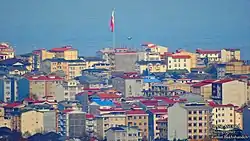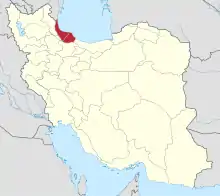Astara, Iran
Astara (pronounced [ɒstaɾɒ] (![]() listen); Persian: آستارا, also romanized as Āstārā)[2] is a city and capital of Astara County, Gilan Province, Iran. It lies on the border with Azerbaijan Republic and on the Caspian Sea. It is an important border trade center between Iran and the Caucasus.
listen); Persian: آستارا, also romanized as Āstārā)[2] is a city and capital of Astara County, Gilan Province, Iran. It lies on the border with Azerbaijan Republic and on the Caspian Sea. It is an important border trade center between Iran and the Caucasus.
Astara
آستارا | |
|---|---|
City | |
 Skyline of Astara | |
 Astara | |
| Coordinates: 38°25′45″N 48°52′19″E | |
| Country | |
| Province | Gilan |
| County | Astara |
| Bakhsh | Central |
| Government | |
| • Mayor | Javad Maayiati |
| • Parliament | Vali Dadashi |
| Population (2016 Census) | |
| • Total | 51,579 [1] |
| Time zone | UTC+3:30 (IRST) |
| • Summer (DST) | UTC+4:30 (IRDT) |
Etymology
It is believed that the name Astara originates from the Talysh language.
History
The earliest mention, under the name Astārāb, comes in the Ḥodūd al-ʿālam, written toward the end of the 10th century. In the 14th century, Astara became the seat of the small principality of the Esfahbad or Espahbad (-bod) of Gīlān. From the 16th to the 18th centuries, the Ṭālešī Khans of Āstārā were either autonomous or nominally subordinate to the governors of Gīlān or Ardabīl; on several occasions they played important parts in the history of the Caspian provinces.[3] According to Minorsky, We do not know whether the later governors of Astara still continued the line of the ispahbads. Even after the conquest of Northern Tālish by the Russians (1813) the family of the Tālish-khans maintained some special rights.[4]
Astara was part of the short lived Talysh Khanate in the 18th and 19th centuries, and for a short while it was the capital of the Khanate before it was moved to Lankaran.[5] In 1828, with the signing of the Treaty of Turkmenchay, Astara was split into two. The city of Astara in Azerbaijan is located just across the Astarachay River.
Tourism
Astara has various attractions and is considered a major tourist destination for Iranians and foreigners, especially those from the Caucasus. The city has a selection of beaches and is near to a Temperate rainforest. Annually over six million Iranians, and six hundred thousand foreigners visit the city.[6] The most popular beaches in this city are Shariati park and sadaf beach. Shariati beach park is located in the city, and Sadaf beach is 7 kilometers far from Astara city[7]
Culture
Astara is home to one of the first libraries established in the country.[8]
Agriculture
Rice has been cultivated in this region for many years, where some indigenous cultivars (landrace) were conventionally bred by farmers.[9]
Climate
Astara has a humid subtropical climate with relatively cold, wet winters and hot, humid summers.
| Climate data for Astara | |||||||||||||
|---|---|---|---|---|---|---|---|---|---|---|---|---|---|
| Month | Jan | Feb | Mar | Apr | May | Jun | Jul | Aug | Sep | Oct | Nov | Dec | Year |
| Average high °C (°F) | 8.8 (47.8) |
8.8 (47.8) |
11.2 (52.2) |
16.6 (61.9) |
22.3 (72.1) |
27.3 (81.1) |
30.5 (86.9) |
29.8 (85.6) |
25.6 (78.1) |
20.3 (68.5) |
15.2 (59.4) |
11.3 (52.3) |
19.0 (66.1) |
| Average low °C (°F) | 1.9 (35.4) |
2.1 (35.8) |
4.8 (40.6) |
9.3 (48.7) |
14.0 (57.2) |
18.1 (64.6) |
20.6 (69.1) |
20.5 (68.9) |
17.5 (63.5) |
13.1 (55.6) |
8.4 (47.1) |
4.3 (39.7) |
11.2 (52.2) |
| Average rainfall mm (inches) | 95.6 (3.76) |
90.2 (3.55) |
108.3 (4.26) |
60.7 (2.39) |
56.5 (2.22) |
45.9 (1.81) |
41.2 (1.62) |
88.8 (3.50) |
230.0 (9.06) |
239.0 (9.41) |
144.6 (5.69) |
91.7 (3.61) |
1,292.5 (50.88) |
| Average rainy days (≥ 1.0 mm) | 11 | 10 | 12 | 10 | 9 | 6 | 4 | 7 | 10 | 13 | 11 | 9 | 112 |
| Average relative humidity (%) | 84 | 85 | 86 | 83 | 80 | 74 | 71 | 75 | 82 | 86 | 87 | 85 | 82 |
| Source: Iranian Meteorological Organization [10] | |||||||||||||
Demographics
The majority of people in Astara are ethnically Azerbaijani and speak the Azeri language.[11][12] However, there is a sizeable Talysh[11] minority in the city. Shia Islam is the predominant religion in the city, however there is also a minority of Sunni Muslims.
Famous people from Astara
- Fereydun Ebrahimi – Procurator-General in Azerbaijan People's Government
- Ebrahim Nabavi – Iranian journalist
- Behzad Behzadi – an author of Azerbaijani language dictionaries
- Payan Rafat – football player
- Kamal Habibollahi – last Commander of the Imperial Iranian Navy
Education
References
- https://www.amar.org.ir/english
- Astara, Iran can be found at GEOnet Names Server, at this link, by opening the Advanced Search box, entering "-3054011" in the "Unique Feature Id" form, and clicking on "Search Database".
- Bazin, Marcel (August 18, 2011) [December 15, 1988]. "ĀSTĀRĀ i. Town and sub-province". In Yarshater, Ehsan (ed.). Encyclopædia Iranica. Fasc. 8. II. New York City: Bibliotheca Persica Press. pp. 837–838. Retrieved January 29, 2018.
- Minorsky, Vladimir (October 1954). "A Mongol Decree of 720/1320 to the Family of Shaykh Zāhid". Bulletin of the School of Oriental and African Studies. London: SOAS, University of London. 16 (3): 515–527. doi:10.1017/S0041977X00086821.
- http://rch.ac.ir/article/Details/7307
- http://www.irna.ir/theme1/fa/pages/4.aspx
- zare, meysam (2019-04-02). "ساحل صدف آستارا". جاذبه های گردشگری - گیلان من (in Persian). Archived from the original on 2019-04-04. Retrieved 2019-04-06.
- http://nikookaran.ir/Portal/Home/ShowPage.aspx?Object=Contact&CategoryID=f1a3ff2a-0a52-497e-966b-297d5d06abd8&WebPartID=a77e46f5-1402-46f2-81bc-778daaff99e6&ID=c3b86c88-5d30-4c26-913c-52e5a0161523
- Pazuki, Arman & Sohani, Mehdi (2013). "Phenotypic evaluation of scutellum-derived calluses in 'Indica' rice cultivars". Acta Agriculturae Slovenica. 101 (2): 239–247. doi:10.2478/acas-2013-0020.
- http://www.irimo.ir/english/statistics/climanormals/gilan/astara.txt
- دائره المعارف بزرگ اسلامی – آستارا
- http://www.gchto.ir/en/pages/about-gilan/astara.php
External links
| Wikimedia Commons has media related to Astara, Iran. |
- Astara entry in the Encyclopædia Iranica
- Pazuki, Arman & Sohani, Mehdi (2013). "Phenotypic evaluation of scutellum-derived calluses in 'Indica' rice cultivars". Acta Agriculturae Slovenica. 101 (2): 239–247. doi:10.2478/acas-2013-0020.
